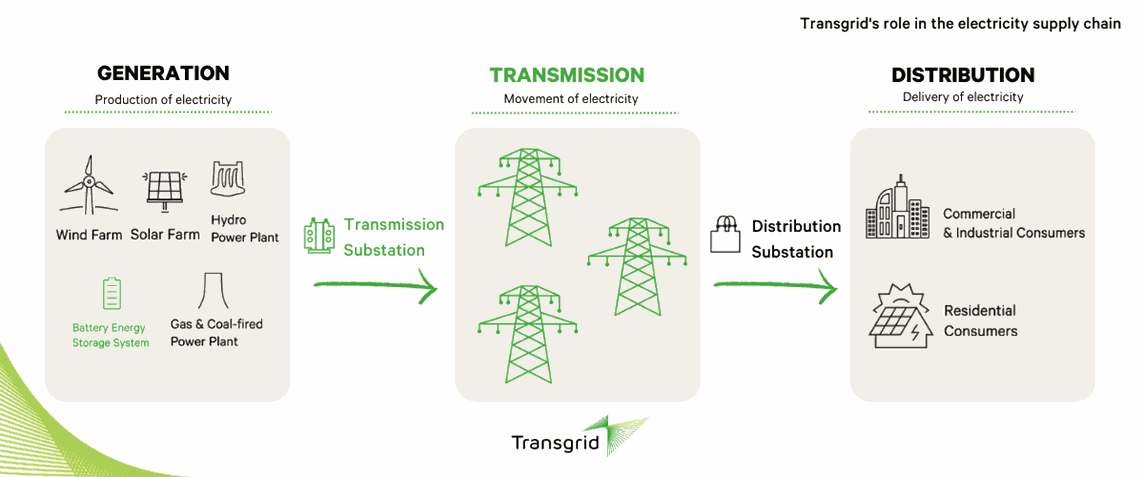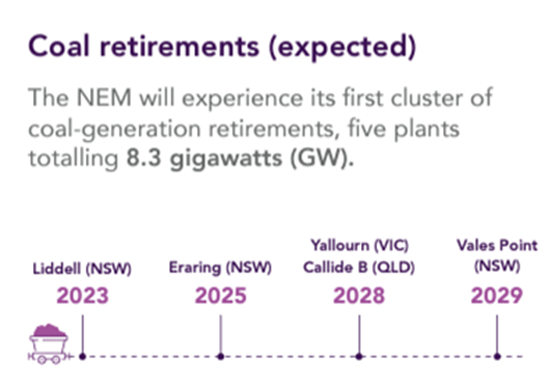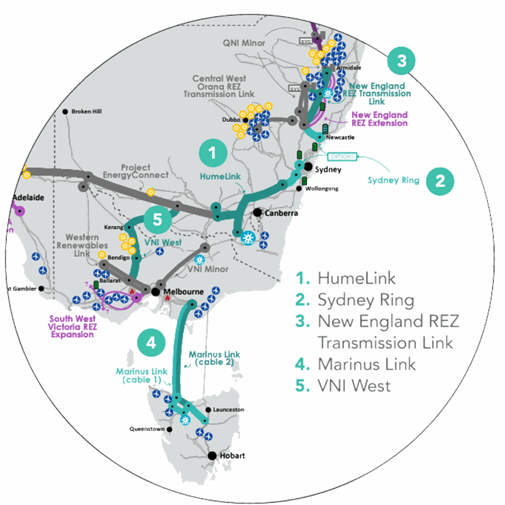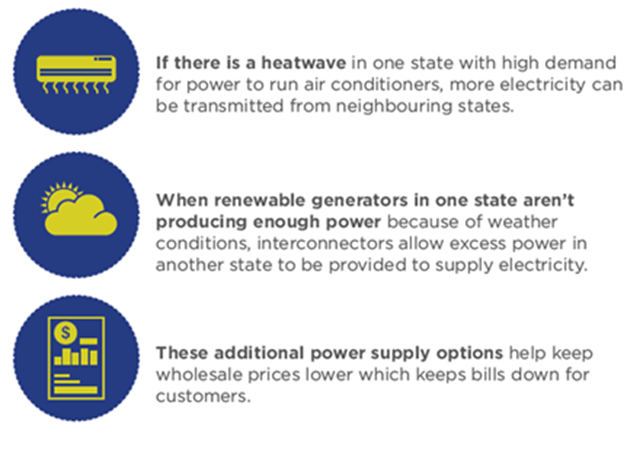Transmission is essential to connect renewable energy generation to the power grid, and into your homes and businesses. Find out why there will be no clean energy transition without transmission, and why we are making it happen now.
23 March 2023
What is energy transmission?
The energy transmission network moves electricity from generation sources such as wind, solar, hydro, gas and coal-fired power plants to large directly connected industrial customers and the distribution networks that deliver it to homes and businesses.

You could consider the energy transmission network like a railway line for energy. And just as railway lines drove the development of cities and industry in the Industrial Revolution, new transmission lines will advance a clean energy future for Australia. It is only through the connection of a high-voltage transmission system that large-scale renewable energy projects can reach homes and businesses and provide greater reliability across states and territories.
The energy transmission system takes high-voltage, bulk electricity from the source (like a power station, and in the future, a renewable energy zone) along high-voltage transmission lines and underground cables to substations. Once there, the substations convert the energy to low-voltage electricity suitable for household use. The distribution network then transmits that low-voltage electricity for use in homes and businesses.
A well-connected transmission system also helps states and territories share energy.
This keeps prices down through competition and provides security and back-up of power supply by linking to a diverse range of energy sources.
Why a new transmission system is critical
The energy network in Australia is changing faster than ever. For decades, energy transmission has largely been focussed on a network of relatively static, centrally-located coal and gas-fired power stations as well as some hydroelectricity. However as AEMO’s 2022 Integrated System Plan (ISP) points out, there will be a rapid change from coal-fired generation to grid-scale wind and solar power by 2050, and this will happen at the same time as electricity use from the grid almost doubles.
AEMO forecasts under the central, ‘Step Change’ scenario that 14GW are set to retire in the next decade. In NSW, AEMO is forecasting that 7.5GW of coal capacity will retire by 2032 (almost three quarters of the coal capacity in the state). Today, around 70% of generation in NSW comes from coal, by 2030 this is forecast to be less than 20% while wind and solar will account for around 70%.

Credit: 2022 Electricity Statement of Opportunities
Recent development has indicated that the coal-fired generators may retire faster than forecast. AEMO has called for urgent investment in generation and transmission capacity to support the transition to low-carbon energy future. In NSW, the staged retirement of the Liddell Power Station has already started, with all units due to be closed in April 2023. The Eraring Power Station has announced it will close in 2025, seven years earlier than previously expected. And the retirement date for the Bayswater Power Station has also been brought forward to “no later than” 2033.
These retiring coal-fired power stations are being replaced by renewable energy sources, such as wind and solar farms that use the power from the sun and wind to generate electricity. The challenge for the energy network is that new renewable energy sources may be built in locations that have not been connected to the electricity grid before. That’s why we need new transmission to connect lower-cost renewable generation to consumers. The growing diversification of the energy generation will require a significant expansion of the transmission network and new storage solutions.
Our current energy system is not prepared for an accelerated coal retirement – and the consequences of not bringing on renewable generation quickly enough could be dire. As we can see in the 2022 Electricity Statement of Opportunities (ESOO) report, it identifies periods when electricity supply won’t meet demand. This is why we must accelerate the development of large transmission infrastructure projects to ensure sufficient supply to meet demand at all times – well before large coal generators retire.
Future-proofing the network
Transgrid’s Energy Vision found the role of the transmission network will be critical under every plausible scenario for the energy transition to occur in the next 30 years. We found that it will move 73%- 95% of all electricity consumed in the NEM (National Electricity Market) in 2050, even if the uptake of rooftop solar and other distributed technologies greatly exceeds current forecasts.
Getting the transmission network equation right and ensuring the network is secure and reliable is critical to the biggest energy transformation of our lifetime and to Australia’s successful transition to net zero.
The 2022 ISP has identified five actionable transmission projects that should progress as urgently as possible to maintain a secure, reliable and affordable supply of electricity to consumers.

Credit: 2022 Electricity Statement of Opportunities
The current scale of the new transmission needed to support the accelerating transition is unprecedented. Despite the many renewable energy projects on the drawing board, planned investment is still behind what is needed to help replace coal power plants while keeping energy supply reliable and affordable. As the operator of the most important electricity transmission network in Australia, Transgrid’s job now is to act quickly and decisively to get the job done.
In fact, over the next five to ten years, Transgrid will invest more than $11 billion to build new transmission infrastructure so the network can accelerate the development of large-scale renewable energy. We are building the critical infrastructure to enable the integration of existing and future wind, solar and hydro power. Our transmission projects EnergyConnect, HumeLink and VNI West will get this energy to market, filling the gap left as coal-fired generators become unreliable and retire.
With the enabling infrastructure in place, it creates confidence for potential project developers. Our transmission projects will also create 7,000 jobs in regional NSW and kickstart $25 billion in economic activity.
EnergyConnect is a key element of the ISP which will deliver the infrastructure required to connect the energy grids of New South Wales, South Australia and Victoria. These connections will enable the wholesale electricity market to expand across these three states, increasing reliability and security of supply.
Another project critical to meeting our future energy needs is HumeLink. It is one of the state's largest energy infrastructure projects and will increase the amount of renewable energy that can be delivered across the national grid. Not only will HumeLink unlock the full capacity of the Snowy 2.0 project, the new 500kV transmission line will link with EnergyConnect at Wagga Wagga – helping to reshape the National Electricity Market.
Planning is also underway for another significant interconnector, VNI West, which will also support greater sharing with Victoria and connect with EnergyConnect near Wagga Wagga.
The benefits of accelerating transmission are clear
Expanding the energy transmission network will not only unlock new sources of renewable energy, it will also deliver greater access to more reliable and affordable electricity. AEMO has calculated that transmission projects in their optimal development path will return benefits more than double the costs (2.2 times).
The access to more renewable energy generation will help to support Australia’s emissions reduction targets and lower power bills for Australians as the cost of coal-fired power generation increases and demand pushes up prices. Fast-tracking the timeline of major transmission projects also provides the NEM with an ‘insurance policy’ to prevent a shortfall of system strength in case more generators accelerate their retirement.
There are also a number of other benefits to the major transmission expansion agenda through the creation of hundreds of construction jobs, and the economic contribution to local communities.
Modelling conducted as part of Transgrid’s Energy Vision shows new interstate transmission interconnection is critical to enable low-cost, secure and reliable electricity between states and will provide some $20 billion in savings to the energy system by 2050.
The energy transition is already underway and it is clear it will require a major transformation of Australia’s transmission network if we are to realise the full benefits of decarbonisation and achieve Australia’s emission reduction goals. There simply can be no transition without transmission, and we’re making it possible.

